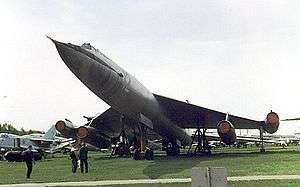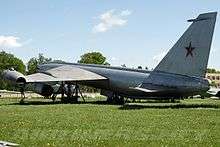Myasishchev M-50
| M-50 | |
|---|---|
 | |
| Myasishchev M-50 on display at Monino Aviation Museum | |
| Role | Supersonic strategic bomber |
| Design group | Myasishchev |
| First flight | 27 October 1959 |
| Status | Retired |
| Primary user | USSR |
| Number built | 1 (+1 static test airframe, 1 M-52) |
The Myasishchev M-50 (Russian: Мясищев М-50) (NATO reporting name Bounder) is a Soviet prototype four-jet engine supersonic strategic bomber, which never attained service. Only one flightworthy prototype was built, which was first flown in October 1959[1]. The M-50 was constructed by the Myasishchev design bureau.
It was a fast jet bomber with four engines: two Dobrynin VD-7 non-afterburning turbojet engines at the outer and two VD-7F afterburning turbojet engines at the inner positions. The two inner engines were located under the wing and the two outer on the wingtips of its shoulder-mounted, truncated delta wings.
The second M-50 was designated M-52 and carried Zubets 16-17 turbofans[2], around which the aircraft had been designed.[3] The engine installation was modified, and a second tailplane added to the top of the fin.[3] M-50 participated in a Soviet Aviation Day flyby in 1961. M-52 was completed but was not flight tested.
Like most of the early 1960s supersonic strategic bomber projects, the M-50/52 program was terminated due to the development of the intercontinental ballistic missiles and the priority assigned to the Soviet space program.
Nuclear bomber hoax
The 1 December 1958 issue of Aviation Week included an article Soviets Flight Testing Nuclear Bomber claiming that the Soviets had made great progress in their own nuclear aircraft program.[4] This was accompanied by an editorial on the topic as well. The magazine claimed that the aircraft was real beyond a doubt, stating that "A nuclear-powered bomber is being flight tested in the Soviet Union. ... It has been observed both in flight and on the ground by a wide variety of foreign observers from Communist and non-Communist countries." In reality, however, the article was a hoax.[5] The aircraft in the photographs was later revealed to be a M-50 and not a nuclear-powered plane at all.
In reality, in the early Sixties Soviet Union did test a technology demonstrator for a nuclear-powered strategic bomber, Tupolev Tu-95LAL, similar to the somewhat earlier American Convair NB-36H project, but, being based on the turboprop Tu-95, it was never supersonic, it never flew under nuclear power (its main goal was to test the nuclear reactor shielding efficiency), and, moreover, it was developed by the Tupolev Design Bureau, as Myasischev company had lost the competition to develop the prototype. It was deemed successful, but further development dragged because of environmental concerns. When the functional ICBMs appeared, the majority of funding and development effort was shifted into that field, and in the late 1960s the project was stopped.
Specifications (M-50A)

Data from [6]
General characteristics
- Crew: 2
- Length: 57.48 m (188 ft 7 in)
- Wingspan: 35.10 m (115 ft 2 in)
- Height: 8.25 m (27 ft 1 in)
- Wing area: 290.6 m2 (3,128 sq ft)
- Empty weight: 85,000 kg (187,393 lb)
- Gross weight: 175,000 kg (385,809 lb)
- Max takeoff weight: 200,000 kg (440,925 lb)
- Powerplant: 2 × Dobrynin VD-7F afterburning turbojet, 137.29 kN (30,865 lbf) thrust each wet
- Powerplant: 2 × Dobrynin VD-7 non-afterburning turbojet, 110 kN (24,000 lbf) thrust each
Performance
- Maximum speed: 1,950 km/h (1,212 mph; 1,053 kn)
- Cruise speed: 1,500 km/h (932 mph; 810 kn)
- Range: 7,400 km (4,598 mi; 3,996 nmi)
- Service ceiling: 16,500 m (54,100 ft)
- Wing loading: 602 kg/m2 (123 lb/sq ft)
- Thrust/weight: 0.29
Armament
- 30,000 kg (66,000 lb) of bombs or missiles carried in internal bays
See also
Aircraft of comparable role, configuration and era
References
- ↑ "M-50 Bounder". www.testpilot.ru. Retrieved 2018-02-14.
- ↑ "M-50 Bounder". www.testpilot.ru. Retrieved 2018-02-14.
- 1 2 Pearce, William. "Myasishchev M-50 / M-52 Bounder". oldmachinepress.com. Retrieved 24 May 2016.
- ↑ Soviets Flight Testing Nuclear Bomber, Aviation Week, 1 December 1958, p. 27.
- ↑ Norris, Guy (14 October 2014). "False Starts For Aviation's Atomic Age". Aviation Week. Retrieved 17 October 2014.
- ↑ Gunston, Bill (1995). The Osprey Encyclopaedia of Russian Aircraft 1875–1995. London: Osprey. ISBN 1-85532-405-9.
External links
| Wikimedia Commons has media related to Myasishchev M-50. |